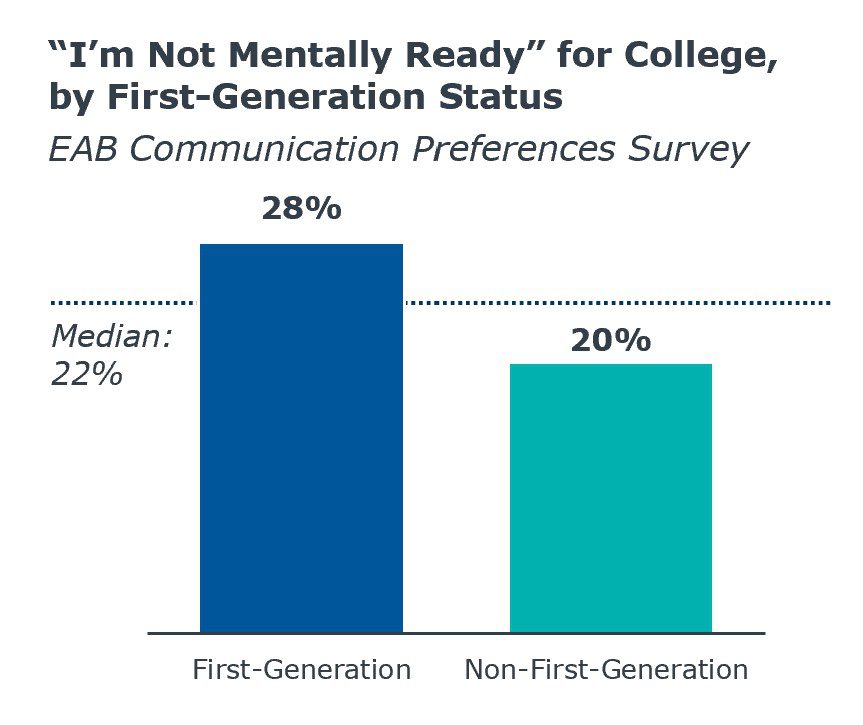“Move-in melt” is on the rise: Why it’s happening and 3 strategies to fight it
“Summer melt” is a familiar challenge for enrollment and student success teams across the country. But as the enrollment landscape evolves, new behavioral trends have emerged, including a phenomenon that we are calling “move-in melt.” Move-in melt is a form of student melt, or attrition, that occurs later in the summer, usually just before or on move-in day—a pivotal moment for incoming freshmen. After observing an increase in move-in melt last year, our team has been monitoring this trend. We’re noticing that summer melt is high this year, which leads us to believe that move-in melt might track similarly to last year, too.
Factors Contributing to Move-In Melt
Based on our last year’s data, we saw move-in melt primarily happening in two student groups: international students and students without financial aid packages where the enrollment team believes they may be eligible for need-based aid. So, what’s going on with these student populations? Due to the extensive paperwork and waiting times involved with the U.S. Visa process, international students may not actually have the necessary paperwork to arrive when planned, despite their enrollment or deposit activity. As for students who didn’t file their FAFSA, many of these students may be first-generation or low-income students who need more support to make it to the first day of classes.
Move-in melt may also be attributed to several traits we’ve learned about Gen P, including significant mental health concerns and cost-related anxieties. This specific cohort of students experienced multiple years of disruption due to the pandemic, which has produced more anxiety, especially around school—some students reporting a feeling of dread as classes begin.
 According to a survey conducted by EAB, 28% of first-generation students reported not feeling mentally prepared for college. And in the past decade, there has been a 17% increase in the diagnosis of anxiety disorders among young people. If mental health issues are shaping Gen P’s college search journey, it is reasonable to assume it’s impacting their ability to commit to a school.
According to a survey conducted by EAB, 28% of first-generation students reported not feeling mentally prepared for college. And in the past decade, there has been a 17% increase in the diagnosis of anxiety disorders among young people. If mental health issues are shaping Gen P’s college search journey, it is reasonable to assume it’s impacting their ability to commit to a school.
College affordability also plays a role in move-in melt. The number of students facing serious financial constraints when it comes to paying for college is expanding. Furthermore, there is an increasing percentage of students, about 60% according to survey data, who question the value of a college education. These cost-related worries contribute to the phenomenon of move-in melt, as students and families grapple with the financial implications and potential long-term consequences of pursuing a college degree.
Fortunately, there are several tried-and-true methods that universities have used to mitigate summer melt, which can also be valuable in reducing move-in melt. Here are three recommendations.
LEARN MORE ABOUT GEN P’S UNIQUE CHARACTERISTICS IN OUR NEW REPORT
3 Ways to Fight Move-in Melt
1. Foster a Sense of Belonging
We know that Gen P is seeking increased connection with their chosen institutions, so building a sense of belonging to your university community is critical to address melt. This is especially important given the growing number of students choosing not go to college— which may influence students who are already on the fence about higher education.
In some cases, melt is amplified because of ineffective communication. By engaging students early with positive messaging, highlighting opportunities for engagement, and offering personalized support, you can help students overcome doubts, strengthen their commitment to your institution, and ultimately show up on your campus each fall. Reducing jargon in your communications will also help first-generation and low-income students feel supported and less like “college outsiders.” Crafting messages that illustrate how you value and support your students can significantly enhance the student onboarding experience and increase the likelihood of persisting to graduation.
SUPPORT BASIC NEEDS SECURITY, A SENSE OF BELONGING, AND STUDENT ENGAGEMENT
2. Reinforce Value Through the Entire Student Journey
Our research shows that multiple factors have contributed to increased skepticism surrounding higher education. Press coverage of controversies, anti-elitist populism, criticism of campus culture, and the allure of a get-rich-quick influencer career have all fueled doubts about the value of a college degree. Perception shifts can also happen quickly; students who felt great about attending your school when they applied may have different opinions today.
This is why communicating with students early and often is so important; you need time to build affinity. As you work to improve communications for your future entering classes, don’t forget to look at the full recruitment journey to see what messages your prospects are receiving and when. Value-focused messages will help you dispel misconceptions by emphasizing the knowledge and relevant job skills student develop at your institution. Additionally, sharing career development resources, internship information, and experiential learning opportunities that connect classroom learning to real-world applications will reinforce the practical value of your degree.
Value-building opportunities at every stage:
Prospective Students
- Highlight Unique Programs and Opportunities: Showcase distinctive academic programs, research opportunities, internships, and extracurricular activities plus the attendant benefits that set your institution apart.
- Personalize Communication: Use personalized emails to highlight virtual tours and campus visit programs that showcase how your institution aligns with their aspirations in a supportive community.
- Emphasize Affordability and Financial Aid Options: Describe scholarship opportunities, grants, and financial aid programs that demonstrate your commitment to making education accessible. Be sure to share updates about how upcoming FAFSA changes will affect affordability.
- Provide Application Support: Go beyond core information about your application process and offer virtual or in-person application workshops and webinars.
- Highlight Admissions Criteria and Transparency: Clearly communicate admission requirements, including GPA, test scores, and extracurricular involvement. Being transparent about the selection process and criteria builds trust and confidence among applicants.
- Showcase Campus Diversity and Inclusion: Emphasize your institution’s commitment to diversity, equity, and inclusion. Highlight programs, initiatives, and student organizations that foster a welcoming and inclusive campus environment.
Accepted Students
- Celebrate Acceptance and Achievements: Extend personalized acceptance letters or emails congratulating students on their admission. Include details about the unique strengths and qualities they will bring to the campus community. Celebrate their success and future promise.
- Offer Exclusive Opportunities: Provide accepted students with access to exclusive events, such as admitted student programs, where they can connect with faculty, current students, and potential peers.
- Showcase Alumni Success: Share stories of successful alumni—focusing on those five years out of college or less—who have excelled in their careers and made a positive impact in their fields. Ask the alumni to focus on how your institution prepared them for a successful career launch and how they were able to smoothly transition into their professional roles. Film testimonials to share how your institution’s education and support have paved the way for their achievements.
Enrolled Students
- Communicate Academic and Support Services: Highlight the academic resources available, including tutoring programs, writing centers, mental health services, career counseling, and faculty mentorship opportunities. Emphasize the breadth and depth of support services that promote student success and well-being.
- Promote Campus Engagement: Showcase the diverse range of student organizations, clubs, and extracurricular activities available on campus. Highlight opportunities for leadership, community service, and personal growth that enrich the college experience and build transferrable job skills.
- Share Alumni Stories and Career Opportunities: Emphasize internship and job placement opportunities, partnerships with employers, and career development services.
3. Leverage Technology, Including AI
Students have high standards for digital experiences, and your summer communications are no exception. As students gear up for their first days of classes, they will likely have many questions about how to prepare. This is a good time to leverage AI via chatbots to reach students when they’re ready, even at the last minute.
HOW GSU USED A CHATBOT TO REDUCE MELT BY 21%
Be sure to incorporate chatbots strategically; relying solely on robotic communications can cause students to feel disconnected from the institution. One approach is to answer frequently asked questions with the bot, and for more in-depth inquiries, direct students to speak with a student advisor.
If you have a virtual tour, you can leverage that tool in your summer communications. Consider sharing tour stops that showcase social areas on campus, mental health resources, and alumni outcomes. Check out our YouVisit Virtual Tours guide to increasing yield here.
Your student success CRM can be another place to connect students with resources, track their progress, and promote “help-seeking behaviors” to reduce melt.
If your team notices a higher-than-usual occurrence of move-in-melt this year, know that you are not alone, and you have options to alleviate it. By understanding the drivers of melt and taking a strategic approach to messaging, you can help students feel more confident in their decision, increasing the odds that they attend your college or university.

More Blogs

The opportunity gap undermining your enrollment strategy

What enrollment leaders can learn from Alabama’s statewide direct admissions program
